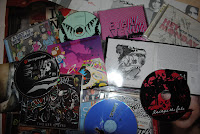The hero's story is also known as the monomyth, and is a term created by Joseph Campbell (1949) in "The hero with a thousand faces" In a similar way to the three act structure, Campbell believed there were three stages to a hero's journey in both films and books; the departure, initiation and return. These three stages are divided up further to create a total of 17 stages of the monomyth.
The first stage of the hero's journey, known as the departure stage, is divided into five further sections:
1. The call to adventure-The hero starts his journey in a state of normality, and then receives information of some sort that causes a problem that will send him/her on an adventure.
2. Refusal of the call-After getting the call to adventure, the hero is reluctant to go. This could be for a number of reasons, including s/he doesn't think the call is important.
3. Supernatural aid-The hero accepts the challenge and is provided with help of some sort to make him/her stronger, wiser etc. than before so they can face this challenge.
4. Crossing the first threshold-The hero starts his/her adventure and is no longer able to turn back.
5. The belly of the whale- The hero is in danger.
The second stage in the hero's journey in a film (or book) is called the initiation stage, which consists of six smaller stages:
1. The road of trials-The hero faces a number of trials where he much achieve success in order to complete his journey.
2. The meeting with the Goddess-The hero meets a mystical or supernatural female who he develops a bond with. 3. Temptation away from the true path- Temptation is presented to the hero that would cause him to fail his journey/mission. This temptation is very often a woman.
4. Atonement with the father-The hero faces a "father-figure" which must be defeated. This father-figure could be a person of high authority or something symbolic.
5. Apotheosis- The hero achieves a higher place after successfully completing the trials he has currently faced.
6. The ultimate boon- This is when the hero has overcome all of his trials and the mission of the journey has been completed. This usually happens after defeating the villain.
The third and final stage is called the return stage, made up of six smaller sections:
1. Refusal of the return- The hero wants to stay in the place where he has reached the ultimate boon.
2. The magic flight- Taking the treasure from the ultimate boon with him, the hero returns home.
3. Rescue from without- The hero is saved from danger or a threat whilst on his way home, usually by an unexpected source.
4. crossing the return threshold-The hero returns home and is no longer in danger.
5. Master of the two worlds- The hero becomes master of the domestic and alien world now that he has successfully completed all of his challenges.
6. Freedom to live- The hero can now live as he chooses because he has conquered the demons/evil which created the call to adventure.
Unlike with the three act structure, not all stages of the hero's journey in accordance the Campbell's theory is present in every film or book, as some are missed out However, they are the only possible stages for the hero's journey, so no matter what film/book the hero is present in, some of these stages will be present.










